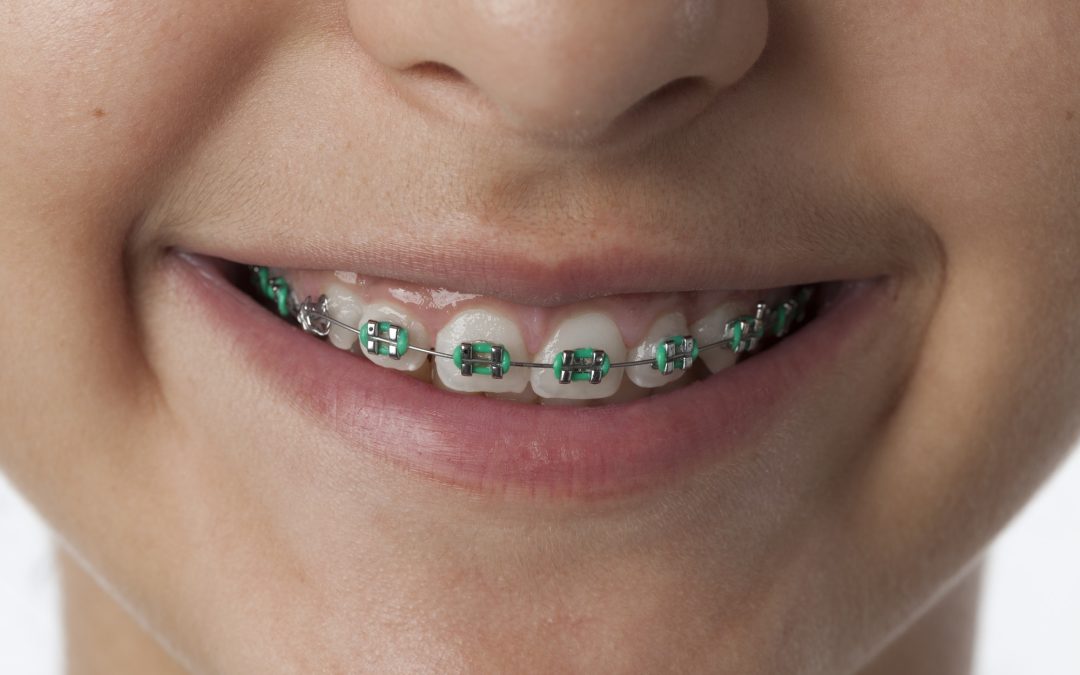Rubber bands or elastics are used by orthodontists to help the braces (traditional metal and even Aligners) do their job. These bands attach themselves to the little hooks on traditional brace work (or slots cut into aligners), adding extra force. While they’re small, the force they exert helps move the teeth into proper alignment, closing up spaces between them, making sure teeth are straightening in the right direction, and improving all kinds of malocclusions (misalignments of the teeth and jaw).
There are different types and sizes of rubber bands, separated into four types. Each one helps correct a specific orthodontic problem and will be given to you by your orthodontist. And we urge you to remember that everyone’s orthodontic needs are different. Always follow the directions given to you by your orthodontist. Keep this in mind as your reading about the following examples.
Class I Elastics
Class I elastics close any spaces between the teeth in the same arch. They usually run from the first or second upper or lower molar and hook to the upper or lower cuspid (or canine) of the same arch.
 Class II Elastics
Class II Elastics
Class II elastics are used for a lot of reasons, but the main one is to help retract the upper teeth and move the lower teeth forward, reducing a horizontal misalignment between the upper and lower front teeth, or what we call an overjet. (This is different from an overbite, which is a vertical misalignment between the upper and lower front teeth.)
The most common configuration of this class of elastics come is:
- Regular Class II elastics run from the upper cuspid hook to the lower first or second molar hook, as instructed by your orthodontist.
- Triangle Class II elastics run from the upper cuspid to the lower first premolar to the lower first molar, forming a triangle shape.
Class III Elastics
Class III elastics retract the lower teeth and advance the upper teeth, reducing underbites. Like Class II, we separate them into two kinds:
- Regular Class III elastics run from the lower cuspid hook to the upper first or second molar hook, as instructed by your orthodontist.
- Triangle Class III elastics run from the lower cuspid to the upper first premolar to the upper first molar, forming a triangle shape.
Vertical Elastics
Vertical elastics come in two forms:
- Posterior box elastics close a posterior open bite. This type of malocclusion happens when the upper and lower anterior teeth (the premolars and molars) do
not come together. The problem creates a gap between the back rows of teeth, even when the patient has their mouth closed. These elastics attach to four teeth, two on top and two on the bottom, to form a box shape.
- Anterior box elastics are used to help close gaps between the upper and lower front teeth. Usually worn only at night, these elastics attach in a box-shape from the upper front two teeth to the lower front two teeth.
- Anterior vertical elastics close an anterior open bite. This is the opposite of the posterior open bite: while the premolars and molars touch, the incisors and canines do not. These elastics attach from the hook on the lower first premolar, up to the hook on the upper cuspid, and then down to the hook on the lower cuspid.
Caring For Your Rubber Bands
Whatever the malocclusion, patients who have to wear rubber bands on braces or aligners should maintain them throughout the day. They must always be in place – this means 24/7, even while the patient is asleep – and changed several times a day. If they break, the patient has to replace them as soon as possible, so keeping a spare pack in a purse, backpack, or pocket is a good idea.
Anyone with braces must follow the care instructions for wearing, using and replacing elastics. While these simple rubber bands are small, they are necessary for achieving positive results! Contact us if you’d like to learn more about orthodontic treatment and the perfect solution for you.


 Class II Elastics
Class II Elastics  not come together. The problem creates a gap between the back rows of teeth, even when the patient has their mouth closed. These elastics attach to four teeth, two on top and two on the bottom, to form a box shape.
not come together. The problem creates a gap between the back rows of teeth, even when the patient has their mouth closed. These elastics attach to four teeth, two on top and two on the bottom, to form a box shape.